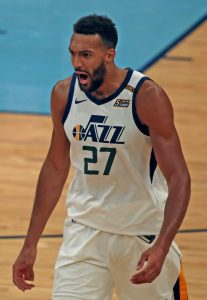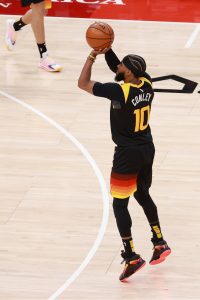After four years as a solid playoff team in the West, the Jazz took a big step forward in 2020/21, finishing the season with the NBA’s best record at 52-20. The club’s regular season success was buoyed by an improved offense, with Mike Conley, Donovan Mitchell, and Bojan Bogdanovic playing key roles.
 Always a strong defensive team since Rudy Gobert‘s emergence as a perennial Defensive Player of the Year candidate, Utah had ranked in the middle of the pack for several years on offense. But in ’20/21, the team’s 116.5 offensive rating was the NBA’s fourth-highest mark and its +9.0 overall net rating was easily the league’s best.
Always a strong defensive team since Rudy Gobert‘s emergence as a perennial Defensive Player of the Year candidate, Utah had ranked in the middle of the pack for several years on offense. But in ’20/21, the team’s 116.5 offensive rating was the NBA’s fourth-highest mark and its +9.0 overall net rating was easily the league’s best.
Unfortunately, the Jazz’s dream regular season didn’t translate to playoff success. Like a number of other clubs, Utah was hit with some bad injury luck at the wrong time, as Conley and Mitchell were both slowed by leg injuries in the postseason.
A knee injury to Clippers star Kawhi Leonard presented a golden opportunity for the Jazz to advance to the Western Finals anyway, but the club was unable to take advantage of the opening and was vanquished in the second round by an L.A. squad missing its leading scorer.
Now, Utah will head into the offseason trying to figure out ways to upgrade its roster despite the team’s extremely limited cap flexibility.
The Jazz’s Offseason Plan:
With former executive VP of basketball operations Dennis Lindsey transitioning to an advisory role, it’ll be up to new head of basketball operations Justin Zanik to determine how the Jazz can contend for a title in 2022.
While only nine players have guaranteed contracts for next season, Utah is already on the hook for nearly $130MM in player salaries, and that total doesn’t include Conley, who will be an unrestricted free agent this offseason. Re-signing Conley is in the Jazz’s best interests — he had a productive 2020/21 season and the club won’t free up any cap space to replace him if he departs.
A new contract for Conley could present some financial issues, however. Even if the point guard takes a pay cut to something in the $15-20MM range (about half of what he earned last season), his deal would take the Jazz well beyond the luxury tax line. The franchise is under new ownership, but we don’t yet know whether Ryan Smith will have the stomach to pay a big tax bill for a roster that has yet to advance beyond the second round of the playoffs.
If the Jazz want to limit their tax penalties, there are essentially two options: letting Conley walk or cutting costs elsewhere. Neither solution is ideal. Conley would be nearly impossible to replace, but the club also doesn’t have any obvious albatross contracts — all its highest-paid players are key contributors to the rotation.
Trimming salary in a trade could mean making veterans like Joe Ingles (one year, $13MM) and Derrick Favors (two years, $20MM) available. Ingles is entering his age-34 season, while the Jazz could probably find a cheaper backup center than Favors.
Jordan Clarkson (three years, $40MM) and Royce O’Neale (three years, $27.5MM) could also be trade candidates. However, Clarkson is an important scorer off the bench and O’Neale is one of Utah’s most versatile defenders — and neither contract is unfavorable.
If Smith doesn’t mind going well into the tax for at least a year, the Jazz could re-sign Conley and then look to reinforce the roster using the taxpayer mid-level exception. Since so few teams have cap room available this summer, Utah could realistically acquire a solid rotation player with that $6MM mid-level.
The Jazz could also make the No. 30 pick in this year’s draft available for veteran help, though the return likely wouldn’t be significant and the team might be better off trying to nail that pick. Adding an inexpensive contributor to the books for the next four years would help offset some of Utah’s pricier contracts.
Salary Cap Situation
Note: Our salary cap projections are based on a presumed 3% increase, which would result in a $112.4MM cap for 2021/22.
Guaranteed Salary
- Rudy Gobert ($35,344,828)
- Donovan Mitchell ($28,103,500) 1
- Bojan Bogdanovic ($18,700,000)
- Joe Ingles ($13,036,364)
- Jordan Clarkson ($12,420,000)
- Derrick Favors ($9,720,900)
- Royce O’Neale ($8,800,000)
- Udoka Azubuike ($2,075,880)
- Elijah Hughes ($1,517,981)
- Total: $129,719,453
Player Options
- None
Team Options
- None
Non-Guaranteed Salary
- Miye Oni ($1,782,621)
- Matt Thomas ($1,782,621) 2
- Total: $3,565,242
Restricted Free Agents
- Juwan Morgan ($1,897,476 qualifying offer / $1,897,476 cap hold): Early Bird rights
- Total (cap holds): $1,897,476
Two-Way Free Agents
Draft Picks
- No. 30 overall pick ($1,994,520)
- Total: $1,994,520
Extension-Eligible Players
- Bojan Bogdanovic (veteran)
- Miye Oni (veteran)
- Matt Thomas (veteran)
Unrestricted Free Agents / Other Cap Holds
 Mike Conley ($39,344,970): Bird rights 4
Mike Conley ($39,344,970): Bird rights 4- Georges Niang ($1,669,178): Bird rights
- Ersan Ilyasova ($1,669,178): Non-Bird rights
- Emmanuel Mudiay ($1,669,178): Non-Bird rights 5
- Total: $44,352,504
Offseason Cap Outlook
It’s a safe bet that the Jazz will be over the cap and at least in the neighborhood of the tax line. Even without re-signing Conley, Utah may be limited to the taxpayer mid-level exception, since using the non-taxpayer MLE would hard-cap the team at the tax apron, which figures to be in the neighborhood of $143MM.
Cap Exceptions Available
- Taxpayer mid-level exception: $5,890,000 6
- Trade exception: $5,005,350
- Trade exception: $2,024,079
- Trade exception: $340,000
Footnotes
- This is a projected value. Mitchell’s salary will be 25% of the 2021/22 salary cap.
- Thomas’ salary becomes fully guaranteed after August 3.
- Because he has been on a two-way contract with the Jazz for two seasons, Brantley is eligible for a standard minimum-salary qualifying offer.
- This is a projected value. Conley’s cap hit will be the maximum salary for a player with 10+ years of NBA service.
- The cap hold for Mudiay remains on the Jazz’s books from a prior season because it hasn’t been renounced. He can’t be used in a sign-and-trade deal.
- This is a projected value.
Salary and cap information from Basketball Insiders, RealGM, and ESPN was used in the creation of this post.
Feels like it was their year to get out of the west! Seemed like now or never an they lost to a Kawhi less clippers ! They don’t really have any way to get better either an really have to pay up to keep Conley to stay similar to last year
So very true all more the reason Mitchell never should of signed his deal. He’s going to demand a trade in a few years like Dame is this year. All these players want the big money and also win then act like babies like Harden to leave a city. Players need to decide what’s more important winning or money.
Jazz have $3m luxury tax room
If don’t pay tax
They have to make salary dump trade for both Bogdan and Ingle
Dump 30th pick with Ingle
If Paul opts in and Payne walks for nothing, the Suns bench is the worst in the nba
Jazz and Suns are in the same boat if they don’t plan to pay $50 million tax each next two years
Let’s hear from everyone who thinks the Jazz should scrap everything they do and start over and do things like every other team and bid for talent other teams are bidding for.
It does seem like they missed a golden opportunity just for lack of a backup “wing” or 2G. But that is no reason to give up or worry about Leonard leaving. How could he or Conley or anyone improve upon best record in the best conference?
Utah made their GM change, which is good news to Snyder at least, who would not play some players, right or wrong (though the scheme of shortening the rotation in the playoffs is well-tested). There is plenty of turnover possible in these bit players that should be tried before changing lead players. Niang is the best of them and is cheap.
I think Leonard twisted his body too much when turning the corner to the rim, finishing up drives. Refs would give him the call but his ambitions are high and he is too good at twist/flinching away from contact to avoid doing so. Leads to soreness maybe injury.
Run it back an get in shape for all our scorers not named Mitchell or Clarkson. Rudy will come back with half a bag of offensive go to moves Plus 2 versions of the sky-hook or just pay homage to a hook move. Play Oni as he shall improve in the Olympics an add another versatile 3 an hella D player wit the tax payers exc
Mitchell was not 100 percent either. Utah will
Make the Semis again.
Mitchell is still in shape. Peak shape an gonna stay that way till bout 32. He’ll strengthen the ankle but 82 games. Body must be ready for our other core players
You need Stars. You need more than one. Look at the Bucks, the Jrue Holiday gamble paid off. Trade away Five Guys or players and picks to get one stud is way worth it for a ring.
I don’t know. Last year Utah’s payroll would suggest they thought they had 3 stars: Mitchell, Gobert, and Conley were all making in the 30M range.
Also, even if we assume they are all stars, none of them are close to as good as Giannis. And I’m not sure packages of Bogdan and Ingles and Clarkson are going to get them that stud either.
Conley and Mitchell did suffer somewhat substantial injuries this year, yet even still it’s hard not to look at this season and say this was Utah’s best chance to get out of the West.
The fact they cratered to a Kawhi-free Clippers team doesn’t exactly make you feel better about their prospects.
As stated above, they don’t have much of a choice with Conley. They have to at least attempt to retain him, because they have no way of replacing him. Yet even if they can retain him, and do it at a reasonable price, we’re still talking about a PG entering his age 34 season next year. How confident do you feel with him as your 3rd best player and 2nd best offensive weapon?
Yet in retrospect Utah probably made the right moves. Conley was a worthwhile gamble. Mitchell is no doubt a max guy. Gobert is controversial, but I’m not sure the trade market for him last summer was any better than it’s going to be this summer. Once you have those guys in place the rest of the roster is going to have to be patched together.
I’m just dubious that an aging Conley and Gobert, with his playoff limitations, is going to be enough around Mitchell to get over the hump in the West. But short of shopping Gobert, I don’t really see a whole lot of substantial moves Utah can make.